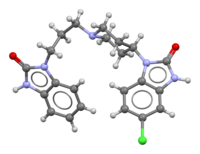
Photo from wikipedia
Introduction/aim The European Medicines Agency (EMA) reviewed the use of domperidone containing medicines in March 2014, due to concerns about cardiac abnormalities. The Medicines and Healthcare products Regulatory Agency (MHRA)… Click to show full abstract
Introduction/aim The European Medicines Agency (EMA) reviewed the use of domperidone containing medicines in March 2014, due to concerns about cardiac abnormalities. The Medicines and Healthcare products Regulatory Agency (MHRA) then responded and issued a drug safety update in May 2014,1 which listed new restricted indications, dosing, duration and contraindications for domperidone.In May 2015 the Neonatal and Paediatric Pharmacists Group (NPPG) released a statement on the use of domperidone.2 This was a highly significant document in child health, and empowered paediatric pharmacists to react to national alerts and implement changes locally. The aim of the audit was to collect information on the current prescribing of domperidone in paediatric patients in a hospital setting, and to evaluate the effects of the alerts on prescribing. Method Patients aged 0–18 years were retrospectively identified within a children’s hospital (n=60) as having domperidone prescribed between the 1 st of January 2014 and the 31 st of July 2015 using electronic prescribing records. For each patient, data was collected regarding domperidone dose, indication, duration, monitoring and non-pharmacological interventions for gastro-oesophageal reflux disease (GORD). Results A total of 60 patients were included in the audit, of which 10 (17%) were prescribed domperidone after the publication of the NPPG alert.In terms of dosing, 43/50 (86%) achieved the standard before the NPPG alert; for duration 6/50 (12%), for indication 9/50 (18%); for ECG monitoring in high risk patients 12/33 (36%) and for the trial of non-pharmacological treatment in GORD 11/17 (64%).For the patients post implementation, these figures were 10/10 (100%), 1/10 (10%), 1/10 (10%), 0/4 (0%) and 2/3 (66%) respectively. Conclusion In conclusion, this audit has shown that the drug safety updates have been received and acted upon within a secondary care setting, and hospital teams are following the new domperidone prescribing guidelines. Whilst many of the children audited were still receiving domperidone off-licence and long-term to improve gastric motility, this is to be expected as there are currently no licensed paediatric medicines for the management of these conditions.After the NPPG alert no patients received unsafe doses or interacting medicines, and the number of patients trialling non-pharmacological treatment for GORD increased. However, there remains a concern that cardiac monitoring is not being undertaken in patients at risk of cardiac defects. It is important to educate healthcare professionals on the cardiac risks of domperidone, and suggest appropriate monitoring in patients with underlying cardiac disease and those receiving concomitant drugs that prolong the QT interval. Clear national guidance, and the introduction of local protocols that recommend which patients need to be monitored and how often may improve domperidone prescribing. References MHRA. Drug safety update: Domperidone: Risks of cardiac side effects. Gov.uk [Internet]. https://www.gov.uk/drug-safety-update/domperidone-risks-of-cardiac-side-effects [Accessed: 30 May 2014]. NPPG. The use of domperidone in infants and children. Neonatal and Paediatric Pharmacy Group [Internet]. http://www.nppg.scot.nhs.uk/news/Domperidone%20NPPG%20final.pdf [Accessed: May 2015].
Journal Title: Archives of Disease in Childhood
Year Published: 2018
Link to full text (if available)
Share on Social Media: Sign Up to like & get
recommendations!